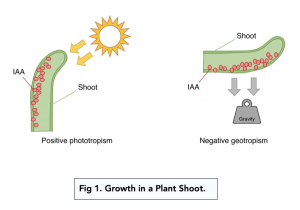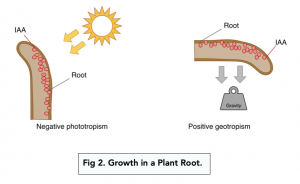Auxin in Phototropism and Geotropism (A-level Biology)
Auxin in Phototropism and Geotropism
Chemical Control in Plants
Auxins are used for chemical control in plants. They have several effects:
- Cell elongation
- Suppression of lateral buds
- Promoting root growth
We will explore some of these effects in this section.
Indoleacetic Acid (IAA)
Indoleacetic acid (IAA) is an important type of auxin, that inhibits growth in the roots and promotes growth in the shoots.
It is transported over long distances through the phloem, and short distances by diffusion and active transport.
Uneven distributions of indoleacetic acid allow for directional growth in the shoots and roots.
Gibberellins
Gibberellin is another type of auxin, that stimulates stem elongation and flowering of plants.
Through stimulating stem elongation, plants can grow to be very tall. They do not inhibit plant growth.
Gibberellins can be inhibited by abscisic acid, which is another hormone.
Phytochrome
Phytochromes are types of photoreceptors, which are found in the leaves of a plant.
There are two types of phytochrome:
- P(R), which absorbs red light. This can be converted into P(FR).
- P(FR), which absorbs far-red light. This can be converted back into P(R).
Phytochrome are important factors in determining when a plant produces flowers.
Growth in the Shoots
- Positive phototropism – IAA redistributes to the shaded side of the shoot. IAA promotes growth in shoots, so the side with the higher concentration will grow faster, therefore the shoot will bend towards the light.
- Negative geotropism – IAA redistributes to the underside of the shoot. IAA promotes growth, so the side with the higher concentration will grow faster, therefore the shoot will bend away from gravity.
- Apical dominance – The shoot tip of a flowering plant is called the apical bud. In order for the apical bud to grow, auxins can inhibit the growth of any other buds, called lateral buds. This allows the shoot tip to grow tall as it is not competing with the lateral buds for sunlight.

Growth in the Roots
- Negative phototropism – IAA redistributes to the shaded side of the shoot. IAA inhibits growth in the roots, so the side with the lower concentration will grow faster, therefore the root will bend away from the light.
- Positive geotropism – IAA redistributes to the underside of the root.
IAA inhibits growth, so the side with the lower concentration will grow faster, therefore the root will bend towards gravity.

Auxin is a plant hormone that plays a crucial role in the growth and development of plants. It is involved in processes such as phototropism (response to light) and geotropism (response to gravity).
Phototropism is the growth of a plant in response to light. It allows plants to orient their leaves and stems towards the source of light for optimal photosynthesis.
Auxin is responsible for promoting elongation on the shaded side of a plant stem. This allows the stem to grow towards the light source. The hormone accumulates on the shaded side, causing cells on that side to grow longer and thus bending the stem towards the light.
Geotropism is the growth of a plant in response to gravity. It allows plants to orient their roots downwards and their stems upwards.
Auxin acts differently in roots and stems. In roots, auxin accumulates at the bottom, causing the cells to elongate and grow downwards. In stems, auxin accumulates at the top, causing the cells to grow upwards. This ensures that roots grow towards the ground and stems grow towards the sky.
Plants need to respond to light and gravity for optimal growth and survival. By orienting their leaves towards light, they can maximize their photosynthetic ability and produce energy. By orienting their roots towards the ground, they can absorb water and nutrients more effectively.
Yes, auxin levels can be manipulated to affect plant growth. For example, by applying synthetic auxins to a plant, scientists can control its direction of growth. This can be useful in agriculture for achieving more efficient crop yields.
Auxin has many potential applications in horticulture and agriculture. For example, it can be used to control the growth of plants, promote root growth, or delay the ageing of fruits. Additionally, auxin can be used in the production of seedless fruits and the creation of plant mutants for breeding purposes.
While auxin has many benefits for agriculture, it can also have some negative effects if not used correctly. Overuse of auxins can lead to imbalanced growth in plants, causing them to become stunted or even die. Additionally, auxins can be harmful to non-target species, such as wildlife, if they come into contact with contaminated water or soil.






Still got a question? Leave a comment
Leave a comment